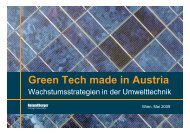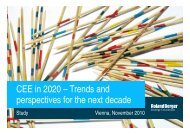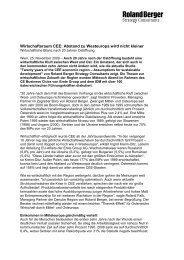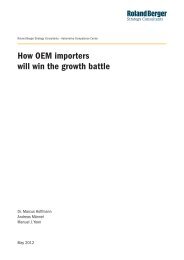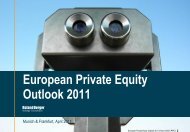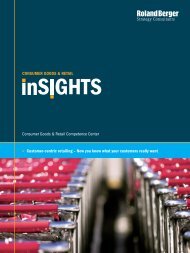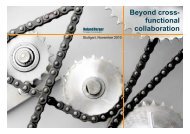Mastering Engineering Service Outsourcing in the automotive industry
Mastering Engineering Service Outsourcing in the automotive industry
Mastering Engineering Service Outsourcing in the automotive industry
You also want an ePaper? Increase the reach of your titles
YUMPU automatically turns print PDFs into web optimized ePapers that Google loves.
15 |<br />
<strong>Master<strong>in</strong>g</strong> <strong>Eng<strong>in</strong>eer<strong>in</strong>g</strong> <strong>Service</strong> <strong>Outsourc<strong>in</strong>g</strong> <strong>in</strong> <strong>the</strong> <strong>automotive</strong> <strong>in</strong>dustry<br />
For those OEMs that do support a globalized R&D <strong>in</strong>frastructure, <strong>the</strong><br />
advantages of offshor<strong>in</strong>g – mostly <strong>the</strong> lower cost base – are frequently<br />
secondary decision factors. The ma<strong>in</strong> driver of <strong>the</strong>ir approach is <strong>the</strong><br />
perceived need to develop vehicles close to end customer markets. In<br />
addition, <strong>the</strong>y might operate <strong>in</strong>dependent brands <strong>in</strong> major markets (like<br />
GM's Opel <strong>in</strong> Germany) which focus on widely different vehicles than<br />
those developed at <strong>the</strong> home-country R&D headquarters.<br />
Automotive companies at <strong>the</strong> forefront of R&D offshor<strong>in</strong>g are actually <strong>the</strong><br />
largest suppliers. Companies like Bosch and Hella have established global<br />
R&D networks that cover all major markets. One reason for this is <strong>the</strong> same<br />
as for OEMs: suppliers must produce market-specific products that can best<br />
be developed at <strong>the</strong> respective location. But <strong>the</strong> o<strong>the</strong>r, and probably more<br />
important, reason is <strong>the</strong> cost pressure that OESs face. Search<strong>in</strong>g for cost<br />
potentials <strong>in</strong> <strong>the</strong>ir R&D <strong>in</strong>frastructure, large OESs realized early on that<br />
offshor<strong>in</strong>g R&D activities to low-cost countries can provide <strong>the</strong>m with<br />
crucial competitive advantages. Therefore, OESs today show a higher level<br />
of R&D offshor<strong>in</strong>g than OEMs. At <strong>the</strong> same time, <strong>the</strong>ir R&D spend levels<br />
are also higher than those of car OEMs. This is driven ma<strong>in</strong>ly by current<br />
<strong>in</strong>dustry dynamics: OEMs are <strong>in</strong>creas<strong>in</strong>gly reliant on suppliers to take over<br />
large parts of development efforts. The revenue-weighted R&D spend is<br />
<strong>the</strong>refore proportionally higher for suppliers than for OEMs.<br />
The approach toward outsourc<strong>in</strong>g is more difficult to generalize across<br />
<strong>in</strong>dustrial groups. To what degree <strong>Eng<strong>in</strong>eer<strong>in</strong>g</strong> <strong>Service</strong> Providers are used to<br />
complement or replace <strong>the</strong>ir own eng<strong>in</strong>eer<strong>in</strong>g capacity seems to be driven<br />
more by <strong>the</strong> historic relationship with specific providers than by a clear<br />
strategic consideration. Some OEMs are heavily <strong>in</strong>volved with ESO companies<br />
(e.g. MB tech is a subsidiary of Daimler, and VW owns a large share<br />
<strong>in</strong> IAV's equity), while o<strong>the</strong>rs are not known to utilize ESO providers significantly,<br />
or only for limited project volumes. Large <strong>automotive</strong> suppliers as<br />
Cont<strong>in</strong>ental and Bosch support <strong>the</strong>ir own <strong>Eng<strong>in</strong>eer<strong>in</strong>g</strong> <strong>Service</strong> Providers<br />
and use <strong>the</strong>m to balance fluctuat<strong>in</strong>g capacity needs. There is thus no<br />
identifiable general trend for ei<strong>the</strong>r car OEMs or suppliers <strong>in</strong> this respect.<br />
In contrast to passenger car OEMs and OESs, commercial vehicle OEMs<br />
pursue a somewhat different R&D strategy. Their R&D facilities are largely<br />
concentrated close to <strong>the</strong>ir headquarters. This is driven by <strong>the</strong> fact that<br />
most commercial vehicle OEMs have traditionally followed such a highly<br />
market-tailored vehicle strategy compared with car OEMs to meet different<br />
regional customer requirements. Therefore, establish<strong>in</strong>g research facilities<br />
<strong>in</strong> emerg<strong>in</strong>g markets, e.g. <strong>in</strong> Asia, was not as necessary as it is for car<br />
OEMs enter<strong>in</strong>g a market with a highly localized product.







